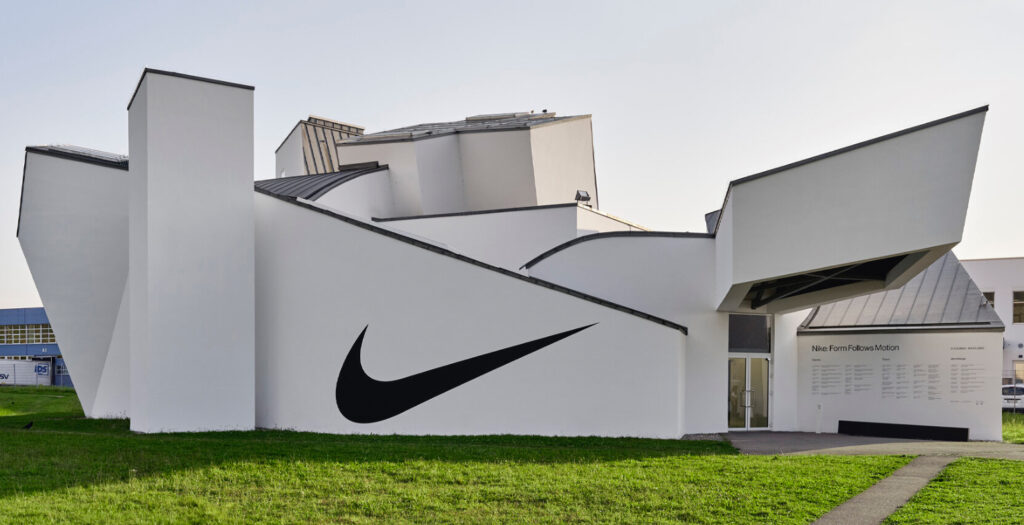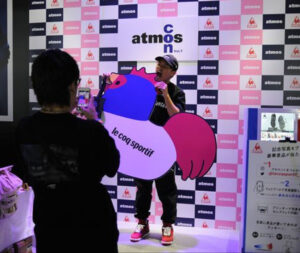The Vitra Design Museum is hosting an exhibition that celebrates one of the most iconic sports brands in the world—NIKE. Titled “NIKE: Form Follows Motion”, the exhibition is an in-depth exploration of Nike’s design history, tracing the company’s evolution from its humble beginnings in the 1960s to its status as a global leader in sportswear and innovation. The exhibition highlights how the brand’s design ethos, grounded in performance, function, and innovation, has shaped both the sporting world and popular culture.
Running parallel with significant global sporting events such as the Olympic and Paralympic Summer Games in Paris and the European Football Championship in Germany, “NIKE: Form Follows Motion” reflects on how Nike’s contributions to sportswear and sneaker culture have gone beyond aesthetics to influence design innovation, sustainability, and social change. The exhibition serves not only as a retrospective of the brand’s storied history but also as a forward-looking glimpse into how sports, design, and culture intertwine in today’s world.
The Origins of Nike: From a Grassroots Start-Up to a Global Powerhouse
Nike’s ascent began in the 1960s as a small startup founded by Bill Bowerman and Phil Knight under the name Blue Ribbon Sports. What started as a company distributing Onitsuka Tiger shoes (now known as ASICS) rapidly transformed into a brand that would revolutionize the sports footwear industry. One of Nike’s early innovations was Bowerman’s development of the “waffle” sole, which improved traction and comfort for runners. This focus on athlete performance through design would become a core tenet of Nike’s philosophy.
In 1971, Blue Ribbon Sports rebranded as Nike, named after the Greek goddess of victory. Around the same time, the now-iconic “swoosh” logo, designed by graphic design student Carolyn Davidson, was introduced. While initially receiving mixed reactions, the swoosh has since become one of the most recognizable logos in the world. Its sleek, dynamic shape embodies motion, speed, and victory, all concepts deeply embedded in the brand’s identity.
Design Meets Innovation: Nike’s Iconic Products
Throughout its five-decade history, Nike has continually pushed the boundaries of design and technology, particularly in the realm of footwear. The Vitra Design Museum’s exhibition pays homage to some of Nike’s most groundbreaking products, including the Air Max and Flyknit, both of which have become cultural icons in their own right.
Air Max: A Revolution in Cushioning
Introduced in 1987, the Air Max line transformed the world of athletic footwear by making Nike’s revolutionary air-cushioning technology visible for the first time. Designed by Tinker Hatfield, the Air Max 1 was the first shoe to feature a “window” in the midsole that revealed the air-cushioning unit, which improved comfort and performance for athletes. This radical design not only elevated the functionality of the shoe but also created a new visual language in footwear design, one that continues to influence sneaker culture today.
Air Max’s design was a bold statement that performance and style could coexist. Its visible air unit became more than just a functional element—it turned into a symbol of innovation and has since been iterated in numerous models, including the Air Max 90, Air Max 95, and Air Max 97. The exhibition showcases these developments, demonstrating how Nike’s emphasis on innovation has redefined the possibilities of sneaker design.
Flyknit: Sustainability Through Design
In 2012, Nike introduced Flyknit, a groundbreaking technology that represented a new direction in footwear construction. Flyknit shoes are made from a single, seamless knitted upper, drastically reducing material waste and providing a lightweight, form-fitting shoe. The innovation came at a time when sustainability was becoming a central concern for many industries, and Nike responded by developing products that combined performance, comfort, and environmentally conscious design.
Flyknit revolutionized footwear not only by reducing Nike’s environmental footprint but also by setting a new standard for what athletic shoes could be. The exhibition highlights Flyknit as a key moment in Nike’s history, showing how the brand has continuously adapted to meet the demands of both athletes and a rapidly changing world. As sustainability becomes an ever more important factor in design, Nike’s research into new materials and manufacturing techniques continues to shape the future of sportswear.
The Intersection of Sports, Design, and Culture
Nike’s influence extends beyond the world of sports into the realms of fashion, culture, and social change. The Vitra Design Museum explores this cultural impression, particularly the almost mythical devotion to sneakers and sportswear that has developed over the past few decades. Sneakers have evolved from being purely functional athletic gear to status symbols, collector’s items, and cultural touchstones.
Much of this cultural shift can be attributed to Nike’s collaborations with artists, designers, and athletes, who have all played a role in elevating the brand’s products to new heights. The exhibition features key collaborations, including Nike’s partnerships with athletes like Michael Jordan and LeBron James, as well as collaborations with high-fashion brands like Off-White and Sacai. These partnerships highlight how Nike has blurred the lines between sportswear and high fashion, cementing its status as a cultural phenomenon.
Additionally, Nike has used its platform to drive social change, particularly in the arenas of racial equality and gender inclusivity. The exhibition examines the brand’s history of activism, from supporting athletes who have taken a stand on social issues, such as Colin Kaepernick, to initiatives that promote inclusivity in sports, like Nike’s Pro Hijab for Muslim athletes. Nike’s commitment to these causes is a reflection of the brand’s broader mission to empower athletes of all kinds, regardless of race, gender, or background.
Sports as a Catalyst for Innovation
The timing of “NIKE: Form Follows Motion” is significant, as it coincides with two of the most important global sporting events—the Olympic and Paralympic Summer Games in Paris and the European Football Championship in Germany. Both events showcase the pinnacle of human athletic achievement, but they also highlight the integral role that design and innovation play in sports.
For Nike, the relationship between sports and design is symbiotic. The brand has long used elite sporting events as testing grounds for its most advanced technologies, from creating lighter, more breathable materials to designing shoes that improve performance on the track, field, or court. The exhibition underscores this connection, demonstrating how Nike’s relentless pursuit of innovation in design has not only benefited athletes but has also led to broader cultural and societal shifts.
Looking to the Future: Materials and Sustainability
As part of its forward-looking mission, “NIKE: Form Follows Motion” also focuses on Nike’s ongoing research into future materials and sustainability. The brand has committed to reducing its environmental impact through initiatives like “Move to Zero”, which aims to achieve zero carbon and zero waste across the company’s supply chain. Nike’s exploration of sustainable materials, such as recycled polyester and plant-based leathers, demonstrates its commitment to addressing climate change and promoting a more sustainable future.
The exhibition presents prototypes and concepts that are shaping the future of Nike’s product lineup, giving visitors a glimpse into the brand’s vision for sustainability in design. These innovations reflect a growing recognition that the future of sports and fashion must prioritize environmental responsibility without compromising performance or style.
Celebrating Five Decades of Design Innovation
“NIKE: Form Follows Motion” is a fitting tribute to a brand that has consistently pushed the boundaries of design, innovation, and culture. From its grassroots beginnings to its status as a global powerhouse, Nike’s influence on the world of sports and beyond is undeniable. The Vitra Design Museum’s exhibition not only celebrates Nike’s past but also looks ahead to its future, highlighting the brand’s ongoing commitment to sustainability, innovation, and social change.
For anyone interested in the intersection of design, culture, and sports, “NIKE: Form Follows Motion” offers an unparalleled look at how one brand has reshaped the way we think about athletic gear, fashion, and the role of sports in society. With its rich history and forward-thinking vision, Nike continues to be a driving force in the world of design—proving that form will always follow motion.
No comments yet.







